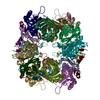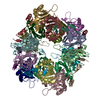[English] 日本語
 Yorodumi
Yorodumi- PDB-9ivs: Cryo-EM structure of the CHIKV nsP3 peptide in complex with the N... -
+ Open data
Open data
- Basic information
Basic information
| Entry | Database: PDB / ID: 9ivs | |||||||||||||||||||||
|---|---|---|---|---|---|---|---|---|---|---|---|---|---|---|---|---|---|---|---|---|---|---|
| Title | Cryo-EM structure of the CHIKV nsP3 peptide in complex with the NTF2L domain of G3BP1 (Conformation III) | |||||||||||||||||||||
 Components Components |
| |||||||||||||||||||||
 Keywords Keywords | VIRAL PROTEIN / Chikungunya virus / nsP3 / G3BP1 / protein-protein interaction. | |||||||||||||||||||||
| Function / homology |  Function and homology information Function and homology informationDNA/RNA helicase activity / host cell filopodium / mRNA methyltransferase activity / polynucleotide 5'-phosphatase activity / poly(A) RNA polymerase activity / mRNA modification / symbiont-mediated suppression of host mRNA transcription via inhibition of RNA polymerase II activity / ribosomal small subunit binding / 7-methylguanosine mRNA capping / positive regulation of type I interferon production ...DNA/RNA helicase activity / host cell filopodium / mRNA methyltransferase activity / polynucleotide 5'-phosphatase activity / poly(A) RNA polymerase activity / mRNA modification / symbiont-mediated suppression of host mRNA transcription via inhibition of RNA polymerase II activity / ribosomal small subunit binding / 7-methylguanosine mRNA capping / positive regulation of type I interferon production / stress granule assembly / cysteine-type peptidase activity / DNA helicase activity / ribonucleoside triphosphate phosphatase activity / molecular condensate scaffold activity / negative regulation of canonical Wnt signaling pathway / host cell cytoplasmic vesicle membrane / cytoplasmic stress granule / endonuclease activity / perikaryon / methylation / defense response to virus / DNA helicase / Ras protein signal transduction / RNA helicase activity / RNA helicase / symbiont-mediated suppression of host gene expression / innate immune response / viral RNA genome replication / focal adhesion / mRNA binding / RNA-directed RNA polymerase activity / DNA-templated transcription / GTP binding / SARS-CoV-2 activates/modulates innate and adaptive immune responses / host cell nucleus / host cell plasma membrane / ATP hydrolysis activity / proteolysis / DNA binding / RNA binding / ATP binding / metal ion binding / nucleus / cytosol / cytoplasm Similarity search - Function | |||||||||||||||||||||
| Biological species |  Homo sapiens (human) Homo sapiens (human)  Chikungunya virus Chikungunya virus | |||||||||||||||||||||
| Method | ELECTRON MICROSCOPY / single particle reconstruction / cryo EM / Resolution: 2.97 Å | |||||||||||||||||||||
 Authors Authors | Wang, J. / Liu, Y.Z. / Lei, J. / Wang, K.T. | |||||||||||||||||||||
| Funding support |  China, 2items China, 2items
| |||||||||||||||||||||
 Citation Citation |  Journal: mBio / Year: 2025 Journal: mBio / Year: 2025Title: Cryo-EM reveals a double oligomeric ring scaffold of the CHIKV nsP3 peptide in complex with the NTF2L domain of host G3BP1. Authors: Yuanzhi Liu / Jie Wang / Yinze Han / Xiaoyan Xia / Rui Zeng / Xinyu Fan / Bo Zhang / Kaituo Wang / Jian Lei /  Abstract: Chikungunya virus (CHIKV) poses a severe threat to global public health. The interaction between CHIKV nsP3 and host G3BP1 is critical for viral replication. However, the exact structural mechanism ...Chikungunya virus (CHIKV) poses a severe threat to global public health. The interaction between CHIKV nsP3 and host G3BP1 is critical for viral replication. However, the exact structural mechanism of the nsP3-G3BP1 interaction is scarce. Here, we report a cryo-electron microscopy structure of an octameric-heterotrimer formed by CHIKV nsP3 peptide (designated as CHIKV-43) in complex with the nuclear translocation factor 2-like (NTF2L) domain of G3BP1. The overall structure presents a double-layer ring scaffold. Two FGDF motifs and two alpha helices of CHIKV-43 are essential to bind NTF2L. Particularly, the secondary alpha helix plays key roles in forming the CHIKV-43-NTF2L high-order oligomer. We next analyzed the detailed interactions between CHIKV-43 and the NTF2L domain. The different binding patterns of NTF2L with its various partners were described as well. Subsequently, we demonstrated that the CHIKV-43 peptide is a crucial factor for nsP3 co-localization with G3BP1, reducing stress granule formation and interfering with interferon production. Overall, our findings present the structural and functional mechanisms on CHIKV nsP3 modulating host G3BP1 and provide a potential antiviral target based on the protein-protein interaction interface. IMPORTANCE: Chikungunya virus (CHIKV) is an arbovirus responsible for causing fever, headache, and severe joint pain in humans, with widespread outbreaks affecting millions worldwide. The CHIKV nsP3 ...IMPORTANCE: Chikungunya virus (CHIKV) is an arbovirus responsible for causing fever, headache, and severe joint pain in humans, with widespread outbreaks affecting millions worldwide. The CHIKV nsP3 is a key protein that interacts with multiple host proteins. In this study, we present the cryo-electron microscopy structure of a high-order oligomer formed by the CHIKV nsP3 peptide and the nuclear translocation factor 2-like (NTF2L) domain of host protein G3BP1, revealing a completely novel interaction model. The detailed interactions within this oligomer were illustrated. We also analyzed the binding patterns of the NTF2L domain of G3BP1 with its various partners, providing essential insights for the development of peptide-mimetic inhibitors targeting nsP3 and/or G3BP1. Furthermore, our data indicate that the nsP3-G3BP1 interaction reduces stress granule formation and antagonizes interferon production. Overall, this study provides new knowledge on CHIKV biology and suggests a potential target for developing antiviral therapeutics. | |||||||||||||||||||||
| History |
|
- Structure visualization
Structure visualization
| Structure viewer | Molecule:  Molmil Molmil Jmol/JSmol Jmol/JSmol |
|---|
- Downloads & links
Downloads & links
- Download
Download
| PDBx/mmCIF format |  9ivs.cif.gz 9ivs.cif.gz | 480.2 KB | Display |  PDBx/mmCIF format PDBx/mmCIF format |
|---|---|---|---|---|
| PDB format |  pdb9ivs.ent.gz pdb9ivs.ent.gz | 397.3 KB | Display |  PDB format PDB format |
| PDBx/mmJSON format |  9ivs.json.gz 9ivs.json.gz | Tree view |  PDBx/mmJSON format PDBx/mmJSON format | |
| Others |  Other downloads Other downloads |
-Validation report
| Summary document |  9ivs_validation.pdf.gz 9ivs_validation.pdf.gz | 513.1 KB | Display |  wwPDB validaton report wwPDB validaton report |
|---|---|---|---|---|
| Full document |  9ivs_full_validation.pdf.gz 9ivs_full_validation.pdf.gz | 574.8 KB | Display | |
| Data in XML |  9ivs_validation.xml.gz 9ivs_validation.xml.gz | 52.3 KB | Display | |
| Data in CIF |  9ivs_validation.cif.gz 9ivs_validation.cif.gz | 81.3 KB | Display | |
| Arichive directory |  https://data.pdbj.org/pub/pdb/validation_reports/iv/9ivs https://data.pdbj.org/pub/pdb/validation_reports/iv/9ivs ftp://data.pdbj.org/pub/pdb/validation_reports/iv/9ivs ftp://data.pdbj.org/pub/pdb/validation_reports/iv/9ivs | HTTPS FTP |
-Related structure data
| Related structure data |  60934MC  9ivqC  9ivrC  9j5sC M: map data used to model this data C: citing same article ( |
|---|---|
| Similar structure data | Similarity search - Function & homology  F&H Search F&H Search |
- Links
Links
- Assembly
Assembly
| Deposited unit | 
|
|---|---|
| 1 |
|
- Components
Components
| #1: Protein | Mass: 16057.231 Da / Num. of mol.: 16 Source method: isolated from a genetically manipulated source Source: (gene. exp.)  Homo sapiens (human) / Gene: G3BP1, G3BP / Production host: Homo sapiens (human) / Gene: G3BP1, G3BP / Production host:  #2: Protein | Mass: 6000.295 Da / Num. of mol.: 8 Source method: isolated from a genetically manipulated source Source: (gene. exp.)   Chikungunya virus / Production host: Chikungunya virus / Production host:  Has protein modification | N | |
|---|
-Experimental details
-Experiment
| Experiment | Method: ELECTRON MICROSCOPY |
|---|---|
| EM experiment | Aggregation state: PARTICLE / 3D reconstruction method: single particle reconstruction |
- Sample preparation
Sample preparation
| Component | Name: CHIKV nsP3 in complex with human G3BP1 / Type: COMPLEX / Entity ID: all / Source: RECOMBINANT | ||||||||||||
|---|---|---|---|---|---|---|---|---|---|---|---|---|---|
| Molecular weight | Experimental value: NO | ||||||||||||
| Source (natural) |
| ||||||||||||
| Source (recombinant) | Organism:  | ||||||||||||
| Buffer solution | pH: 7.5 | ||||||||||||
| Specimen | Embedding applied: NO / Shadowing applied: NO / Staining applied: NO / Vitrification applied: YES | ||||||||||||
| Vitrification | Instrument: CRYOSOL VITROJET / Cryogen name: ETHANE / Humidity: 100 % / Chamber temperature: 277.15 K |
- Electron microscopy imaging
Electron microscopy imaging
| Experimental equipment |  Model: Titan Krios / Image courtesy: FEI Company |
|---|---|
| Microscopy | Model: TFS KRIOS |
| Electron gun | Electron source:  FIELD EMISSION GUN / Accelerating voltage: 300 kV / Illumination mode: OTHER FIELD EMISSION GUN / Accelerating voltage: 300 kV / Illumination mode: OTHER |
| Electron lens | Mode: BRIGHT FIELD / Nominal defocus max: 2500 nm / Nominal defocus min: 1000 nm |
| Image recording | Electron dose: 40 e/Å2 / Film or detector model: FEI FALCON IV (4k x 4k) |
- Processing
Processing
| EM software |
| ||||||||||||||||||||||||
|---|---|---|---|---|---|---|---|---|---|---|---|---|---|---|---|---|---|---|---|---|---|---|---|---|---|
| CTF correction | Type: PHASE FLIPPING AND AMPLITUDE CORRECTION | ||||||||||||||||||||||||
| 3D reconstruction | Resolution: 2.97 Å / Resolution method: FSC 0.143 CUT-OFF / Num. of particles: 161792 / Symmetry type: POINT | ||||||||||||||||||||||||
| Refinement | Highest resolution: 2.97 Å Stereochemistry target values: REAL-SPACE (WEIGHTED MAP SUM AT ATOM CENTERS) | ||||||||||||||||||||||||
| Refine LS restraints |
|
 Movie
Movie Controller
Controller




 PDBj
PDBj
